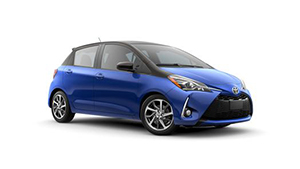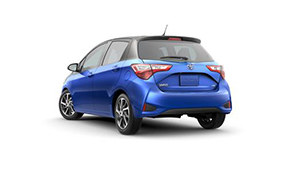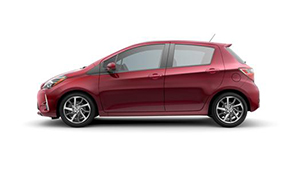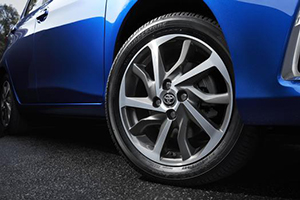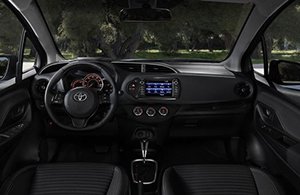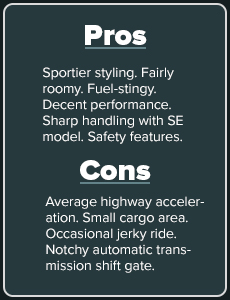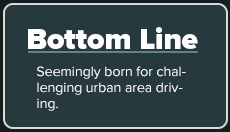2018 Toyota Yaris
The 2018 Toyota Yaris
hatchback gets sportier styling and is generally fun to drive.
Prices: $15,635-$19,060
A top car mechanic and restorer has told me most people will buy any
car as long as it looks good. Maybe so. A sportier appearance promises
to help sell the 2018 subcompact Toyota Yaris, and its frugal nature
may also help move it from dealer lots.
The new Yaris hatchback, which shouldn’t be confused with the
larger Mazda-based Toyota Yaris iA, comes with two or four doors. (Why
some call four-door hatchbacks “five-door” vehicles
seems odd. Anybody ever see anyone use the hatch entrance as a door?)
The 2018 Toyota Yaris looks sportier with a bold front fascia that
features a new grille and updated headlight design. The rear has wider
horizontal tail lights and a revised lower bumper to give the car a
wider-looking “hot hatch” look. The 155.5-inch-long
Yaris really doesn’t look all that small, although
it has only a 98.8-inch wheelbase.
The Yaris comes in L, LE and SE trim levels. I tested the top-line
sporty SE, which has a unique front piano black mesh grille and chrome
trim. It also has a sport suspension, rear spoiler and 16-inch machined
alloy wheels with dark accents that carry wider (50-series vs.
65-series) tires. The SE thus is the most fun-to-drive Yaris version.
My test car had an electronically controlled 4-speed automatic
transmission with a responsive manual-shift feature, although the Yaris
is available with a 5-speed manual in the two door L and four-door SE.
A four-speed automatic seems old-fashioned, but Toyota probably figures
the car’s engine works best with a four-speed automatic. Or
it’s just trying to keep the car’s price down. In
any case, the automatic’s console-mounted shift gate is
notchy—likely to prevent drivers from selecting the wrong
gear.
List prices, excluding delivery and processing charges, range from
$15,635 for the base two-door L hatchback with the manual transmission
to $19,060 for the SE four-door hatchback with the automatic. The SE
with the manual costs $18,260, and the L with the automatic is $16,385.
All Versa versions have a sophisticated 1.5-liter 106 horsepower
dual-overhead-camshaft four-cylinder with variable valve timing. It
provides lively acceleration to highway speeds but delivers just
average 65-75 passing times. The engine loves to rev but drones when
asked to work hard. Still, it’s reasonably quiet for a small
four-cylinder. Fast cruising in no problem, partly because the car has
been given a quieter interior.
Only regular grade fuel is needed, and estimated fuel economy is 30
miles per gallon in the city and 36 on highways with the manual and 30
and 35 with the automatic.
My test SE’s thick steering wheel controlled the electric
power steering, which was fast (2.65 turns lock-to-lock) and had a firm
feel and decent road feedback. The car stayed flat in curves taken at
above-average speeds. Its handling was helped by its wider tires, sport
suspension, stabilizer bar, vehicle stability control and traction
control.
However, the short wheelbase and firm suspension occasionally resulted
in a jerky ride. Thus, I wouldn’t call the SE a comfortable
long-distance car. However, higher-profile tires and such may allow the
L and LE versions to have a more comfortable ride.
Four-wheel disc brakes are controlled by a pedal with a linear feel and
bite hard.
The base Yaris L comes with standard items such as air conditioning,
tilt (but not telescopic) wheel with integrated audio controls,
integrated backup camera display and power door locks and windows. Both
the L and LE have an Entune Multimedia bundle that includes a 6.1-inch
touch screen display, AM/FM/CD player, MP3/WMA playback capability, six
speakers, auxiliary input jack, USB 2.0 port with iPod connectivity and
control, hands-fee phone capability and music streaming via Bluetooth
and Siri Eyes Free.
The SE gets what Toyota calls a “big-car-kind” of
audio upgrade with Entune Audio Plus with connected navigation app
using a 7-inch high-resolution touch screen.
The LE adds power mirrors, cruise control and steering wheel audio
controls. The SE includes LE interior upgrades and sport-fabric trimmed
seats with contrast white stitching, piano black interior trim accents
and the audio upgrade.
My test car’s doors opened wide for easy entry and placement
of child seats. The car is rated as a five-seater, but while three
adults can sit comfortably, drivers with long legs will wish their seat
moved back further. And a tall occupant behind the driver will want a
little more knee room. At least the center of the rear seat has a soft
cushion. The large, comfortable front sets offers decent side support.
The hatch opens high and wide, but the small cargo area
couldn’t hold an average week’s worth of groceries.
However, flipping the 60/40 split rear seat backs forward greatly
enhanced cargo space.
The analog and digital instrumentation can be quickly read, and the
touch-screen display is simple to use. Climate controls are
conveniently handled by large round dashboard dials, although twin
cupholders are placed a little low in the front console, where the
automatic shift lever sometimes partially blocks them. Rear occupants
get a single cupholder placed at floor level at the end of the front
console. The interior is generally attractive but has a good amount
of hard plastic, which at least is easy to clean.
The four-door model’s front doors have storage pockets, and
the dual extendable sun visors have (unlit) vanity mirrors.
A clever feature is a wet-arm windshield wiper system that sprays
washer fluid from the base of the wiper arm directly into the
blade’s path for improved cleaning. (Why haven’t
other automakers thought of this?) All Yaris versions come with a
standard rear window wiper.
There are nine air bags, including side curtain shield bags, lane
departure alert, and Toyota’s Star Safety System, which
includes electronic brake force distribution and Smart Stop technology.
The heavy hood is held open by a prop rod, but the important engine oil
filler tube is located front and center.
The Yaris has a rigid body structure that makes it feel ready for tough
urban driving wars. The SE is especially handy in such combat.
